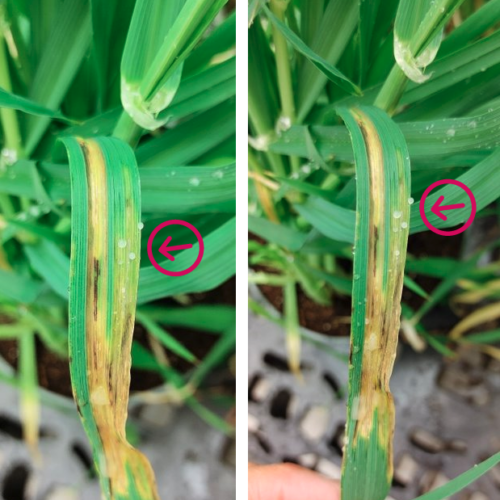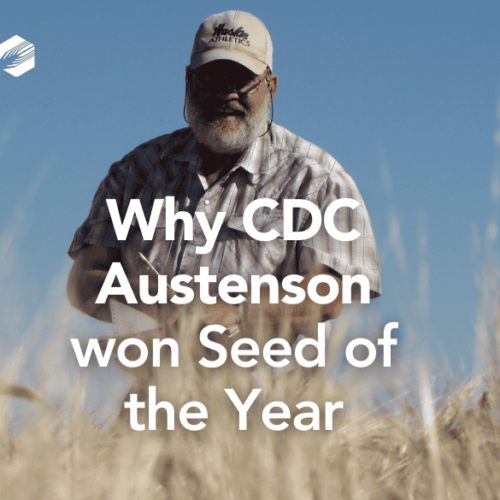Barley Production Resources
From managing FHB and understanding chit, to battling herbicide-resistant weeds and optimizing your natural air drying (NAD) systems, SaskBarley provides resources to make it easier for you to grow quality barley in Saskatchewan.
Search the categories below:

Bacterial Leaf Streak and Black Chaff of Cereal Crops in the Prairies
Bacterial leaf streak is an important disease of cereal crops all over the world and can cause a significant reduction in yield – in some cases up to 50 per cent. Here’s an extension resource on the ongoing research into these harmful diseases.


Reminder: Keep Treated Seed Out of Your Grain Deliveries
Treated seed contamination in grain deliveries can lead to financial penalties & harm Canada’s reputation. Learn how to keep your grain clean & meet quality standards.

PAMI Answers 8 Common Questions About Grain Drying and Storage
The following is a summary of frequently asked questions about grain drying and storage by PAMI. They also provide guidance on where to look for reference material on the topic.

Post-Harvest Guide: Essential Fall Management Strategies for Your Farm
Prepare for a successful next season by addressing fall management tasks like nutrient management, weed control, insect pressure, and residue management. Learn the best practices for soil testing, fertilizer application, and pest management.

Harvest Sample Program – Get a Free Assessment of Your Grain’s Quality
Take advantage of the free Harvest Sample Program offered by the CGC and gain valuable insights into your product. Understanding the quality of what’s in your bins can help you make more informed marketing decisions. Learn more…

2024 Saskatchewan Seed Survey Interim Results
This survey provides a record of seed-borne pathogen trends in pulse and cereal crops and allows for continued tracking of diseases over time.

A Quick Checklist for Seeding Malt Barley in Saskatchewan
Get ready for a successful malt barley season! This quick checklist for seeding barley covers variety selection, seeding rates, disease management, and fertility strategies to help Saskatchewan barley farmers boost yield and meet malt quality standards.

Why CDC Austenson Won 2025 Seed of the Year from SeedWorld
CDC Austenson, two-row feed barley was named Seed of the Year for 2025 by SeedWorld. Retired barley breeder, Dr. Brian Rossnagel, formerly of the Crop Development Centre (CDC) in Saskatoon, SK examines why this feed variety has been so popular among Western Canadian farmers.

Unlocking Barley’s Potential: New Varieties and Advances in Plant Breeding
Discover new malt and feed barley varieties for 2025 and learn about the latest advancements in barley breeding technology from Dr. Aaron Beattie of the Crop Development Centre.

A Quick Tip on Kochia Management from Dr. Charles Geddes, AAFC
Dr. Charles Geddes of AAFC answers the question: If you’ve got a major kochia problem, what steps would you take mitigate that problem in a long-term drought?

A Short Note on Kochia Control from the 2023 Season
By Mitchell Japp, MSc, PAg

Fall Considerations: Wrapping up the Growing Season
At the end of the harvest season there are still decisions to be made that can help set the farm up for success in the following year. In addition to evaluating decisions made throughout the year, we can begin addressing nutrient management, weed risks, insect pressure and more.

Managing Kochia in Barley: Effective Strategies for Season-Long Control
Learn how to manage kochia in barley fields with effective pre-harvest and post-harvest strategies. Reduce seed production and control herbicide-resistant kochia for better crop competition.
Barley Production Resources
From managing FHB and understanding chit, to battling herbicide-resistant weeds and optimizing your natural air drying (NAD) systems, SaskBarley provides resources to make it easier for you to grow quality barley year-after-year.
Search the categories below:
Navigating the New FHB Risk Mapping Tool
New FHB risk mapping tool for farmers! Introducing the prairie-wide Fusarium Head Blight (FHB) risk maps, a game-changer in disease management. Learn how to navigate this FHB monitoring tool and how these maps can revolutionize your crop protection plan. Read more…
Prairie Crop Disease Monitoring Network Introduces Enhanced Quick Disease Reporter Tool for the Prairie Region
To help facilitate awareness of developing plant disease issues on a regional- and prairie-wide basis, the Prairie Crop Disease Monitoring Network (PCDMN) and the Agriculture and Agri-Food Canada (AAFC) Geomatics Group have collaborated on the development and deployment of the Prairie Crop Disease Monitoring Network Quick Disease Reporter Tool (PCDMN QDRT).
Bacterial Leaf Streak and Black Chaff of Cereal Crops in the Prairies
Bacterial leaf streak is an important disease of cereal crops all over the world and can cause a significant reduction in yield – in some cases up to 50 per cent. Here’s an extension resource on the ongoing research into these harmful diseases.
Get More from Your Barley: Join the Harvest Sample Program
Looking to get more out of your barley crop this year? The Canadian Grain Commission’s Harvest Sample Program offers barley producers free, valuable data that can help when marketing and delivering your grain.
Are Plant Growth Regulators (PGRs) Worth It for Your Barley Crop?
Chris Holzapfel, Research Manager at IHARF presents recent agronomic research studying the effect on lodging when applying different rates and mixes of plant growth regulators (PGRs) to barley.
Reminder: Keep Treated Seed Out of Your Grain Deliveries
Treated seed contamination in grain deliveries can lead to financial penalties & harm Canada’s reputation. Learn how to keep your grain clean & meet quality standards.
Beyond Austenson: Game Changing New Feed Barley Varieties
Discover farmer funded new feed barley varieties that offer higher yields, better standability and more modern disease packages. Read more…
Malt Barley Seeding and Production Recommendations
Four malt barley agronomy and marketing experts provide malt barley seeding and production recommendations and discuss the agronomic and economic benefits of growing barley.
2024 Saskatchewan Seed Survey Interim Results
This survey provides a record of seed-borne pathogen trends in pulse and cereal crops and allows for continued tracking of diseases over time.
Keep it Clean: Understanding Market Risks and Ensuring Crop Marketability
Review the 2024 Product Advisory when building your crop protection plan. The recently released 2024 Product Advisory from KeepItClean.ca serves as a crucial resource for growers navigating the complexities of crop protection products and their potential impact on marketability.
Top Considerations of Early Season Weed Control in Cereals
Early season weed control can be key to optimizing yield and giving your crop a good head start. Even small weeds compete with your crop for moisture and nutrients while also acting as a host for insects and diseases. Controlling weeds while they are small prevents competition with the crop and in many cases improves herbicide efficacy. Here are our top considerations for early season weed control…
A Quick Tip on Kochia Management from Dr. Charles Geddes, AAFC
Dr. Charles Geddes of AAFC answers the question: If you’ve got a major kochia problem, what steps would you take mitigate that problem in a long-term drought?

